Ria Keburia Foundation
23.10.2025
სიხარული, მწუხარება, შიში, სიყვარული, ვნება, ტკივილი, შფოთვა და იმედი — ამ განცდებს ხელოვანი ელენე მეტრეველი მის მიმდინარე გამოფენა Human States–ში იკვლევს, რომელიც კაჭრეთში, 21 ნოემბერს რია ქებურიას საგამოფენო სივრცეში გაიხსნა. Human States წარმოადგენს მრავალშრიან რეფლექსიას მხატვრის ცხოვრებაზე, სამყაროს აღქმასა და საკუთარ პრაქტიკაზე. ეს არის ამბავი ადამიანური მოწყვლადობის, თვითანალიზსა და თვითაღმოჩენის. წარდგენილი ნამუშევრებითა და ცენტრალური პერფორმანსით, ელენე მეტრეველი მაყურებელს უბიძგებს, გახდეს ამ გამოცდილების ნაწილი და შეძლოს ინტერაქცია. „ამარტა“-სთან ინტერვიუში, არტისტი გვიზიარებს დეტალებს თავისი ცხოვრებისა და პრაქტიკის შესახებ, გვანახვებს, რა გზა განვლო ამჟამინდელ მდგომარეობასა და რეალობამდე.
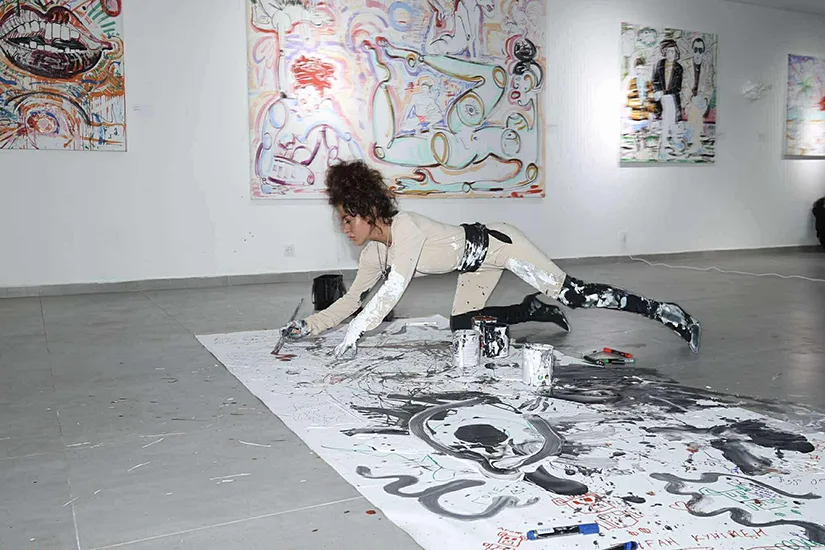
Joy, sadness, fear, love, passion, pain, panic and hope, these are the emotions artist Elene Metreveli explores in her exhibition Human States at Ria Keburia Foundation. Ongoing from twenty first of November in Kachreti, Georgia. Human States is a multi layered reflection of artists’ life and her perception on the world, on her practice. A story that speaks of human vulnerability, self reflection and self discovery. With her works and a performance as a central piece, Elene Metreveli invites viewers to become a part of an exclusive experience and to contribute to the works with their interaction. In a candid interview with Amarta magazine, artist shares intimate details of her life and practice, showing us what lead her to current states and moments.
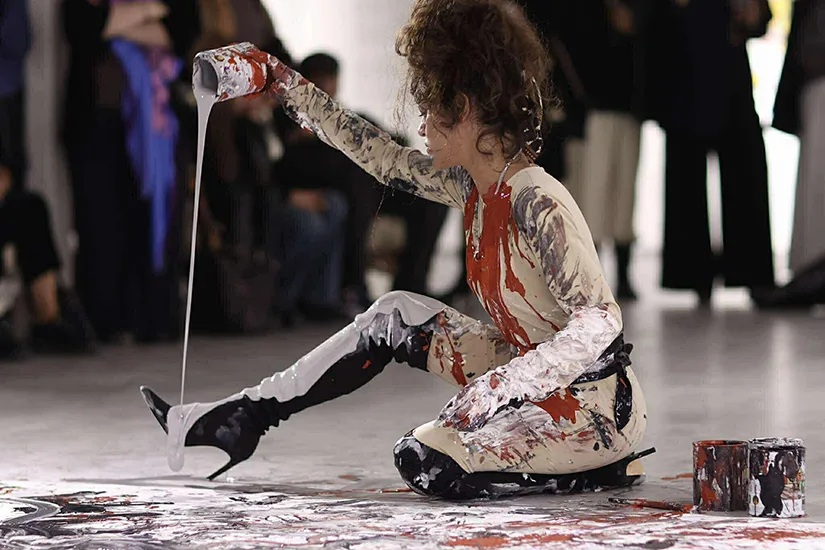
თქვენს პრაქტიკაში მიმართავთ ფერწერას, ქანდაკებასა და დიზაინს — გაგვიზიარეთ როგორ განსაზღვრავთ საკუთარ თავს როგორც ხელოვანი?
You’ve worked across painting, sculpture, performance and design — how do you define yourself as an artist today?
ხელოვნებაში დიდი სპექტრი მაქვს; მგონი ეს გამომდინარეობს იქიდან, რომ ბავშვობიდან ვხატავ. მიუხედავად ამისა, სწავლა არქიტექტურის განხრით განვაგრძე, რამაც თავის მხრივ ბევრი ახალი ინტერესი გააჩინა ჩემს ცხოვრებაში, განსაკუთრებით კი დიზაინის მიმართ. ალბათ, ამ მომენტიდან დაიწყო ჩემი პრაქტიკის მრავალფეროვნება. გარკვეული პერიოდი ვმუშაობდი ჩანთების დიზაინერად, ამ საქმიანობაში ერთმანეთს ერწყმოდა ხატვის სიყვარული, ასევე არქტიტექტურის და დიზაინის განხრით მიღებული ცოდნა. ვთვლი, რომ დღეს მოდასა და ხელოვნებას შორის ნაკლებად მკაცრი საზღვრებია, ჩემთვის მოდა ხელოვნებაა. აქედან გამომდინარე, საკუთარ თავს ვხედავ, როგორც მულტიმედია არტისტს, ვუსმენ იმ მოთხოვნილებებს რაც მაქვს, ყურადღების დიდ ნაწილს ხელოვნებას ვუთმობ; ასე გამოვხატავ იმას, რისი თქმაც მსურს და რაც ჩემს გარშემო ხდება.
I have a wide range in art; this comes from the fact that I’ve been drawing since childhood. Nevertheless, I continued my studies in architecture, which in turn sparked many new interests in my life — especially toward design. That’s probably when the diversity of my practice began.
For a while, I worked as a bag designer, where my love for drawing merged with the knowledge I had gained from architecture and design. Fashion and design have always been part of my surrounding environment. I believe that today the boundaries between fashion and art are much less strict — for me, fashion is art.
Therefore, I see myself as a multimedia artist. I listen to my own needs and impulses, but I dedicate most of my attention to art — it’s how I express what I want to say and what’s happening around me.
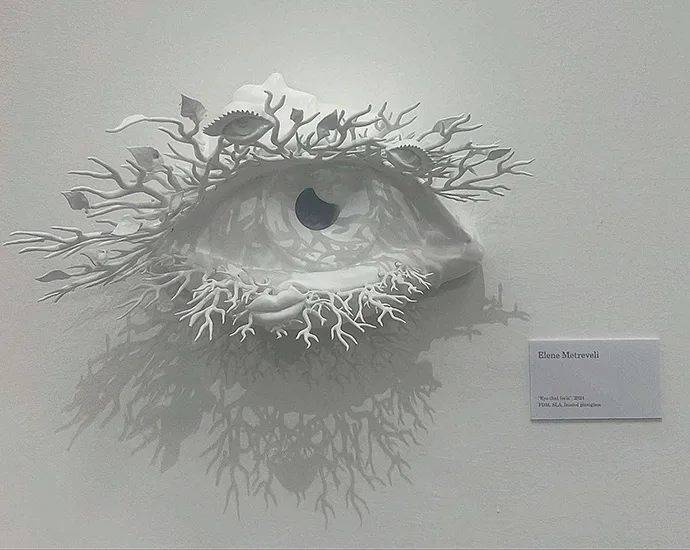
თქვენ ცხოვრებასა და კარიერაში გარდამტეხი მომენტი იყო 2018 წელს მხედველობის დაკარგვა. აღიქვამთ თუ არა მას შემდეგ ხელოვნებას განსხვავებულად?
Your story took a dramatic turn when you began losing your eyesight in 2018. How did that experience change your understanding of art and perception?
6 წლის წინ დავკარგე მხედველობა. მას შემდეგ მხედველობას პერიოდულად ნაწილობრივ ვკარგავ და აღვიდგენ, ამის გამო ძალიან ბევრი რამე იცვლება ყოველდღიურობაში. ადრეული ასაკიდანვე მადლიერი ვიყავი ყველაფრისთვის რაც მქონდა, თითქოს ვგრძნობდი რომ მუდმივ ცვლილებებთან მომიწევდა ცხოვრება. სიხარულით მავსებდა მუსიკაც კი და გარემომცველი სამყარო, რომლის მიმართ უკვე ძალიან სენსიტიური ვიყავი. ეს ფასეულებობები, სულ არსებობდა ჩემში, თუმცა მხედველობის ნაწილობრივ აღდგენის შემდეგ მივხვდი, რომ უფრო მგრძნობიარე ვარ დროის მიმართ. არვიცი რა როგორ განვითარდება მომავალში და ამიტომ ვგრძნობ პასუხისმგებლობას, რომ უნდა მოვასწრო იმის გაკეთება რაც ჩემში მუდმივად ტრიალებს. შეიცვალა ისიც, რომ ყოველი ოპერაციის შემდეგ თავიდან ვსწავლობ იმას, რაც თითქოს უკვე ვიცოდი. მიწევს მოვერგო ახალ რეალობას და ვისწავლო მასთან თანაცხოვრება. განსაკუთრებით გამიძლიერდა ფონური ხმების აღქმა, უფრო მესმის სამყაროს ექო. ამ ცვლილებებს შევიგრძნობ საკუთარ თავსა და გარემოზე.
Six years ago I completely lost vision in my eyes, since then there are periods when I partially regain but also lose sight, because of my diagnosis of diabetes this process becomes even more challenging.
From an early age, I was always deeply grateful for everything I had, as if I somehow felt that things would change from time to time. Even music and the surrounding world filled me with joy, to which I was already very sensitive. These values had always existed within me, but after partially regaining my sight, I realized that I had become even more sensitive to time. I don’t know how things will develop in the future, and that’s why I feel a responsibility to do everything that constantly revolves inside me, to create while I still can.
After every surgery, I have to relearn what I I already knew and to adapt to a new reality. Relearning has become a part of my practice. My perception of background sounds has become especially strong; I can hear the echo of the world more vividly. I feel these changes both within myself and in the environment around me.
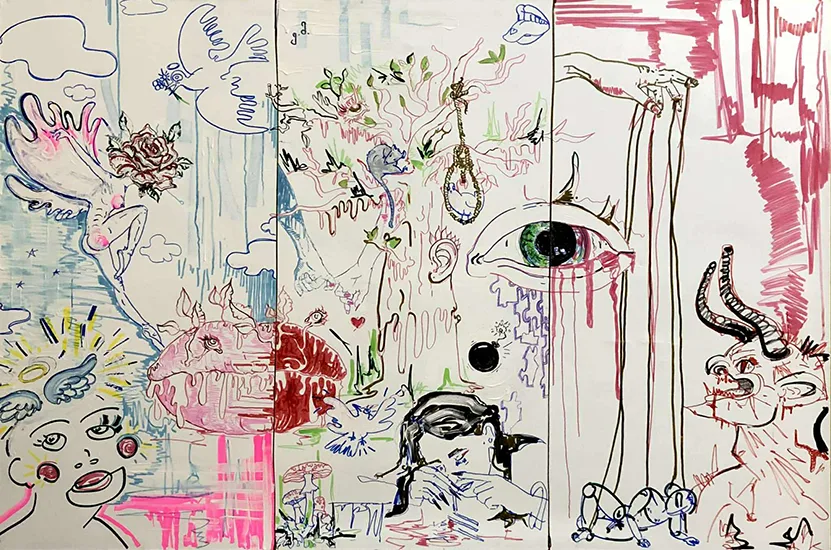
ნამუშევრებში The Eye That Feels და Blind Art, იკვლევთ სხვა შეგრძნებებით დანახვის იდეას. როგორ ითარგმნება შეხება, სმენა ან ინტუიცია ვიზუალურ ენაზე? რა როლი აქვს ამ გრძნობას თქვენს შემოქმედებით პროცესში?
In your works like The Eye That Feels and Blind Art, you explore the idea of seeing through other senses. How do you translate touch, sound, or intuition into visual language? What role does vulnerability play in your creative process?
Blind Art შეიქმნა იმ პერიოდში, როდესაც საერთოდ ვერ ვხედავდი. ასისტენტების დახმარებით გავაკეთე სერია. თითო ნამუშევრის დასრულებას ვუთმობდით ერთ საათამდე, რადგან დროში არ დამეკარგა საწყისი წერტილი და სტრუქტურა. მხედველობის დაბრუნების შემდეგ, რამდენიმე ნამუშევარი აბსოლუტურად ხელუხლებლად დავტოვე, რამდენიმეში კი შევიტანე ცვლილებები. ამ პროცესში ჩამოყალიბდა ახალი განზომილება – შერწყმა ორი მდგომარეობის, როდესაც ვხედავ და როდესაც ვერ ვხედავ. მუშაობის დროს მხედველობა მიუარესდება ხოლმე. ასეთ მომენტებში თვალებს ვხუჭავ და ვიწყებ ინტიუიციურად ხატვას. ამაში მსგავსებას ვხედავ ხელოვნურ ინტელექტთან და ამიტომ დაინტერესებული ვარ ამ სივრცითაც. მეც თითქოს მსგავსად ვიგონებ და ვასრულებს იმას რასაც ვერ ვუყურებ. The Eye That Feels, არის გაცოცხლებული ვერსია იმისა, რასაც ვქმნი. ადამიანს აქვს ხუთი მთავარი შეგრძნება. სწორედ ამ შეგრძნებების კვლევაზეა დაყრდნობილი ქანდაკებების ეს სერია.
Blind Art was created during a period when I couldn’t see at all. With the help of assistants, I produced a series of works. We would dedicate up to an hour to completing each piece so that I wouldn’t lose the initial point and structure over time.
After regaining my vision, I left some of the works completely untouched, while I made changes to others. Through this process, a new dimension emerged in my art — the fusion of two states: when I can see and when I cannot.
While working, my eyesight sometimes worsens; in those moments, I close my eyes and begin to work intuitively. I see a similarity between this and artificial intelligence, which is why I’m also interested in that field. In a way, I invent and complete what I cannot see.
The Eye That Feels is the enlivened version of what I create. Humans have five primary senses, and the series of sculptures is based precisely on the exploration of these senses.
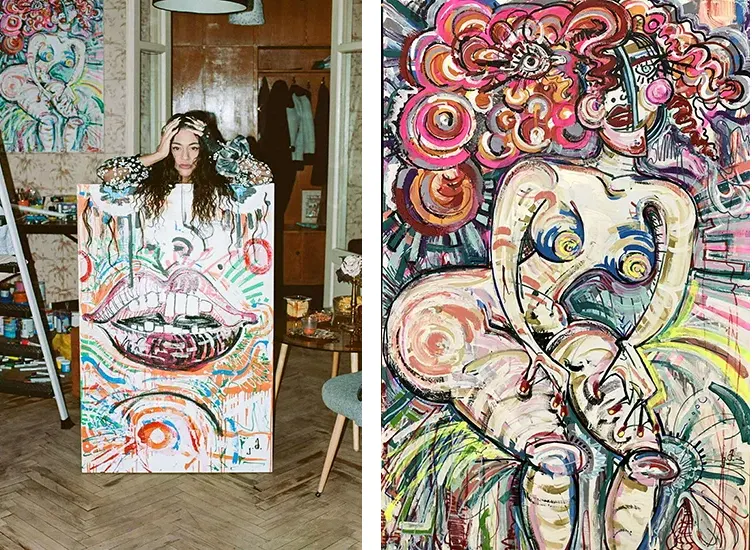
როგორ აღიქვამთ ფერს და რა როლს ანიჭებთ მას თქვენს ხელოვნებაში?
What is color for you, what place does it hold in your art?
ფერი ყოველთვის მნიშვნელოვანი იყო ჩემს ცხოვრებაში, მათი შერწყმა და წინააღმდეგობრივობაში მოყვანა სულ მაინტერესებდა. ამ კონტრასტებს ვხედავ ემოციის დონეზე. დღეს ფერებს განსხვავებულად აღვიქვამ, მხედველობის პრობლემის გამო ხშირად სხვა ფერს ვხედავ. შეიძლება აღმოჩნდეს, რომ ლურჯი რომელიც გამოვიყენე ნამუშევარში, რეალურად არის სხვა ტონალობა. ეს რა თქმა უნდა, პროცესში ცვლის თანმიმდევრულობას, ჩემში გარკვეულ კონფლიქტსაც იწვევდა, თუმცა ახლა მგონია, რომ ეს მომენტი საინტერესოა კიდეც. საბოლოოდ, ვიღებ პროდუქტს, რომელსაც სულ სხვანაირად ვხედავ. ნამუშევარს ვაძლევ თავისუფლებას, რომ იარსებოს შებოჭილი ხედვის მიღმა. ყოველთვის ვცდილობ საუკეთესო მხარე დავინახო და მასთან ერთად განვაგრძო მუშაობა. ზოგადად არ მაქვს განსაზღვრული, რომ ჩემი ხელოვნება უნდა იყოს მკაცრად ფერადი ან მონოქრომული, ამ გადაწყვეტილებას ვიღებ გრძნობისა და განცდის საფუძველზე.
Color has always been important in my life — I’ve always been fascinated by how colors blend and contrast with one another. I perceive these contrasts on an emotional level. Today, I experience colors differently; because of my vision problem, I often see a different color than it actually is. It might turn out that the blue I used in a work is, in reality, another shade. Naturally, this changes the consistency of the process.
At first, this created a kind of inner conflict for me, but now I find it interesting. In the end, I arrive at a result that I had seen differently at certain moments, and I allow the work the freedom to exist beyond limited perception. I always try to see the positive side and continue working with it.
In general, I don’t have a fixed rule that my art must be strictly colorful or monochromatic — I make that decision based on feeling and emotion.
პერფორმანსებში Inside Flower, In the Momentდა Paint Me Tender , აქტიურად იწვევთ მაყურებელს მონაწილეობის მიღებაში. როგორ აკონტროლებთ სპონტანურობას ამ დროს და გინდათ თუ არა, რომ მნახველი გახდეს ნამუშევრის ნაწილი?
Many of your performances — like Inside Flower, In the Moment, and Paint Me Tender — actively involve the audience. Why is it important for you to make the viewer part of the artwork and how do you balance control and spontaneity in your performances?
თითქმის ყველა ჩემი პერფორმანსი უბიძგებს მაყურებელს კონტრიბუციისკენ. ეს არის ერთგვარი გაცოცხლება ნამუშევრის, ახალი სამყაროს შექმნა, ენერგეტიკის და გარემომცველი მუხტის თავმოყრა და კონტრასტების გამოაშკარავება. პერფორმანსი მაძლევს სივრცეს გავიზიარო მომენტი ადამიანებთან, მე არ ვიცი რა ხდება მათ შინაგან სამყაროში, მაგრამ ვპოულობ იმ ადგილს და დროს, როდესაც განვიცდით მსგავს შეგრძნებებს. პერფორმანსი ხდება მედიუმი სხვადასხვა ენერგეტიკებს შორის. მდგომარეობების გაერთიანება ახალ სივრცეში ამ სისწრაფით ძალიან საინტერესო და შთამბეჭდავია ჩემთვის.
ჩემს გამოფენაში, რომელიც ტარდება რია ქებურიას სივრცეში, ეს ჩართულობა კიდევ უფრო ახალი სახით შედგა. ეს არის კოლაბორაციული პერფორმანსი კომპოზიტორ გაო ხართან ერთად და ვოკალისტ ქეით პანტერასთან. მუსიკის და ქორეოგრაფიის მედიუმით სპონტანურად ვყვებით ერთმანეთს. გაო ხარი უკრავს საავტორო ნაწარმოებებს, ისევე როგორც ჩვენთვის უკვე ცნობილ კომპოზიციებს და ვფიქრობ ესაა პერფორმანსის ემოციური საყრდენი.
Almost all of my performances encourage audience participation. It’s a kind of reanimation of the artwork — the creation of a new world, a gathering of energy and surrounding charge, and a revelation of contrasts. Performance gives me the space to share a moment with these people. I don’t know what is happening in their inner world, but I find that place and time where we experience similar feelings. The performance becomes a medium between different energies. The merging of these states into a new space, with such immediacy, is very interesting and inspiring to me.
In my exhibition, which takes place at the Ria Keburia space, this participation takes an even newer form. It is a collaborative performance with the composer Gao Khar and vocalist Kate Panthera. Through the mediums of music and choreography, we spontaneously respond to each other. Gao Khar performs her own compositions as well as some familiar pieces, and I believe this serves as the emotional foundation of the performance.
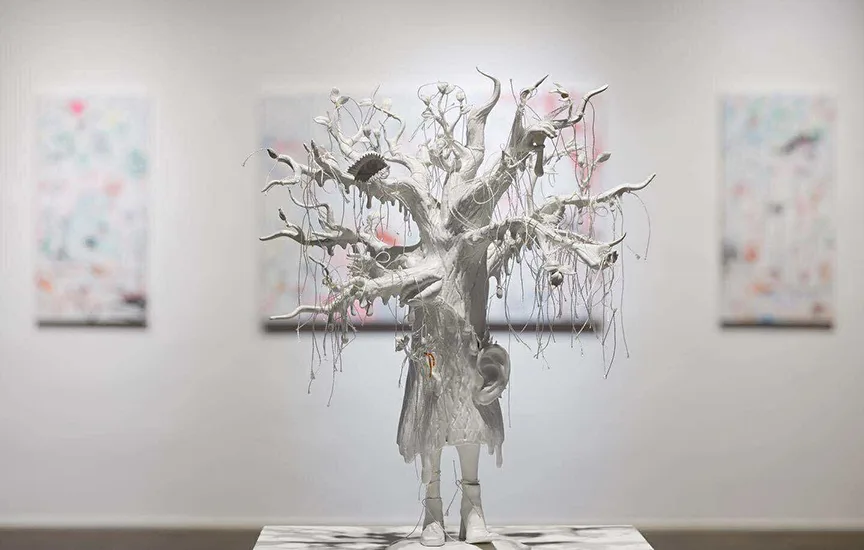
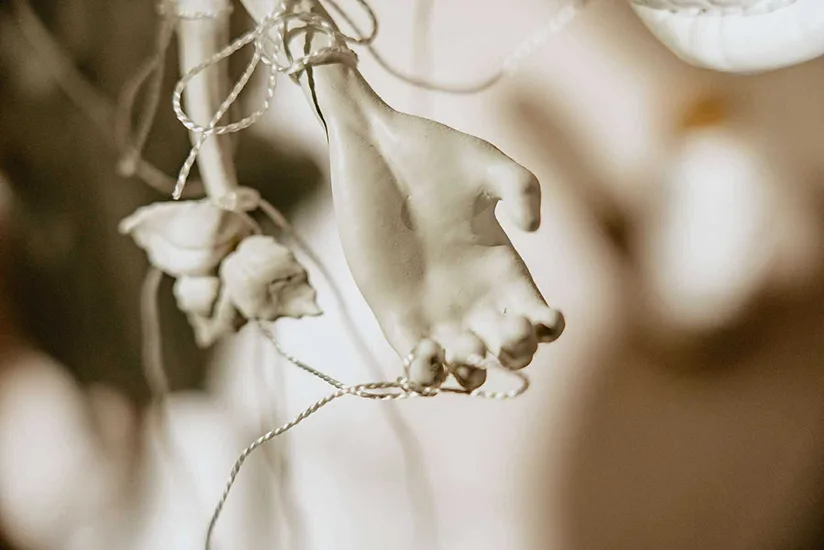
ნამუშევარი Dream Tree–ს კონცეფცია არის ის, რომ ადამიანებმა სურვილები ჩაიფიქრონ — თითქოს ეს არის საკმაოდ პერსონალური, თუმცა ამავდროულად ინტერაქტიული მიდგომა. რა იყო მისი შექმნის ინსპირაცია?
The Dream Tree invites people to make wishes — it feels both deeply personal and communal. What inspired this approach and the work?
ნამუშევარი Dream Tree, რომელიც თენგიზ აბულაძის ფილმის, ნატვრის ხის ისნპირაციით შევქმენი, ვიზუალურად გამოსახავს შეგრძნების ხუთივე ელემენტს. ინტეგრირებულია ყურის და თვალის ვიზუალიც. ძაფები, რომლებსაც მნახველი კრავდა, აძლევდა შესაძლებლობას შეხებოდა ნამუშევარს, ჩაეფიქრებინა სურვილი. ამ პროცესში შეხებას გრძნობდა ხეც. კონცეფციაც იმაშია, რომ არის რაღაცები რასაც ვხედავთ, თუმცა ვერ ვგრძნობთ. ეს ხე კი არის მეტაფორა სამყაროს ამოძახილის, ის გვეხმარება დავინახოთ ის რაც ჩვენშია, ჩვენ გარშემოა, ვხედავთ, მაგრამ არ გვესმის. გულწრფელად გვანახებს საკუთარ ქვეცნობიერს და უფრო მეტს ვიგებთ მის შესახებ.
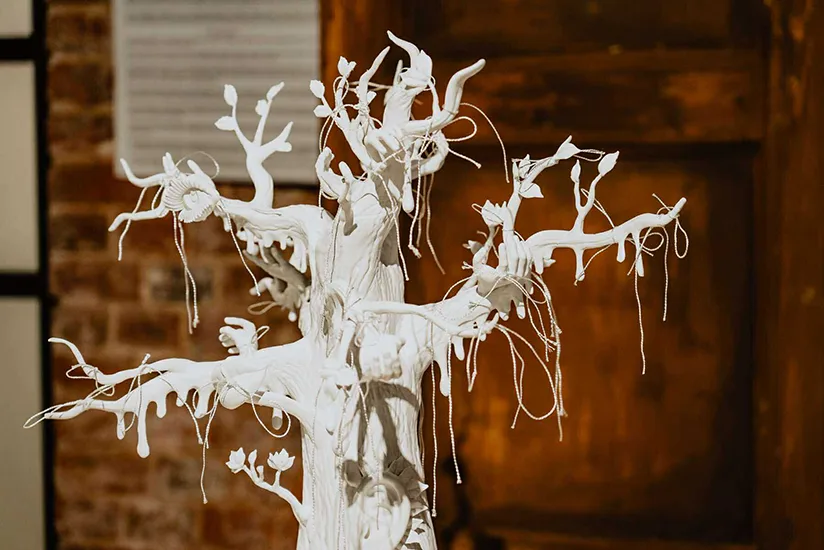
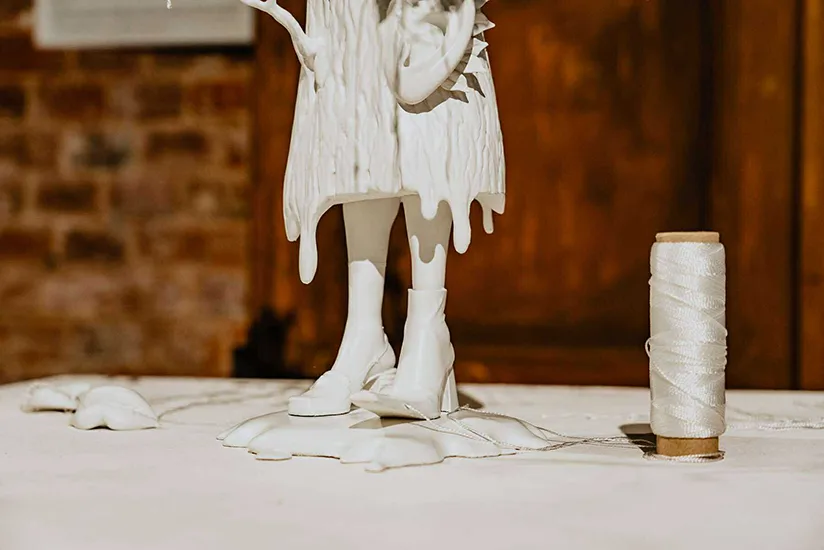
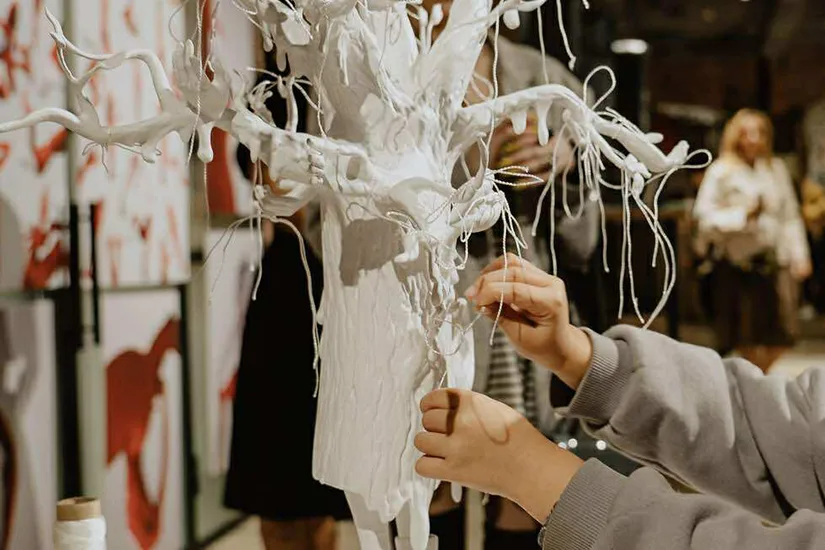
The work Dream Tree, inspired by Tengiz Abuladze’s film The Wishing Tree, visually represents all five elements of sensation. The visuals of the ear and the eye are also integrated. The threads that viewers would tie onto the tree gave them the opportunity to touch the work and make a wish. In this process, the tree itself could “feel” the touch.
The concept lies in the idea that there are things we can see but cannot feel. The tree serves as a metaphor for the echo of the world — it helps us perceive what is within us and around us, what we see but do not understand. It sincerely reveals our subconscious and allows us to learn more about it.
ფიქრობთ, რომ თქვენი ხელოვნება არის ერთგვარი ინსტრუმენტი, თერაპიის, სულიერებისა თუ აქტივიზმის — ან თუნდაც სრულიად განსხვავებული რამ?
Do you see your art as a kind of therapy, spirituality, or activism — or something else entirely?
ალბათ, ჩემი ხელოვნება ამ ყველა ასპექტს შეიცავს. ის მკურნალიც არის ანუ გზა, რომ ყველანაირი ემოცია ნამუშევრით გამოვხატო და არ დავიტოვო უარყოფითი განცდები.
My art probably encompasses all of these aspects. It is also healing — a way for me to express every kind of emotion through my work and not hold on to negative feelings.
თქვენ გქონიათ კოლაბორაცია ისეთ ცნობილ მოდის დიზაინერებთან, როგორიც არის გურამ გვასალია. როგორ დაახასიათებდით კავშირს მოდასა და სახვით ხელოვნებას შორის?
You’ve collaborated with major fashion designers like Guram Gvasalia and brands such as Palmer Johnson. How do you see the relationship between fashion and fine art?
მე ვარ ადამიანი, რომელსაც ძალიან აინტერესებს ყველაფერი. არის რაღაცები რაშიც ვერ ვერკვევი, თუმცა ინტერესი მაინც არ ქრება და მოტივირებული ვარ, რომ ბევრ კოლაბორაციულ პროექტზე ვიმუშაო, შევეხო ჩემთვის ახალ თემებს და ვიყო გახსნილი კონტრასტული ხედვების გამოაშკარავებისთვის.
გურამთან მუშაობა ერთ-ერთი ყველაზე საინტერესო პროცესი იყო, დიდ პატივს ვცემ მის პრაქტიკას და რწმენას საკუთარ საქმეში. კოლაბორაცია ითვალისწინებდა მისი დაწერილი წიგნის Size Zero – სთვის ნამუშევრების შექმნას. წიგნი ეხებოდა ცხოვრების თავიდან დაწყების თემატიკას, რაც ჩემს ბიოგრაფიასთან მჭიდრო კავშირშია. მე შევქმენი ექვსი ფერწერა თითოეული თავისთვის. ნამუშევრები შემდგომ პარიზში, ერთობლივ გამოფენაზე წარვადგინეთ.
I’m a person who is deeply curious about everything. There are things I don’t fully understand, yet my interest never fades — I’m motivated to work on many collaborative projects, explore new topics, and remain open to revealing contrasting perspectives.
Working with Guram was one of the most interesting experiences for me. I have great respect for his practice and his faith in his work. Our collaboration involved creating works for his book Size Zero. The book deals with the theme of starting life anew, which closely relates to my own biography. I created six paintings, one for each chapter of the book, and later we presented these works together at a joint exhibition in Paris.
გვესაუბრეთ თქვენს გამოფენაზე, რომელსაც რია ქებურიას საგამოფენო სივრცე მასპინძლობს?
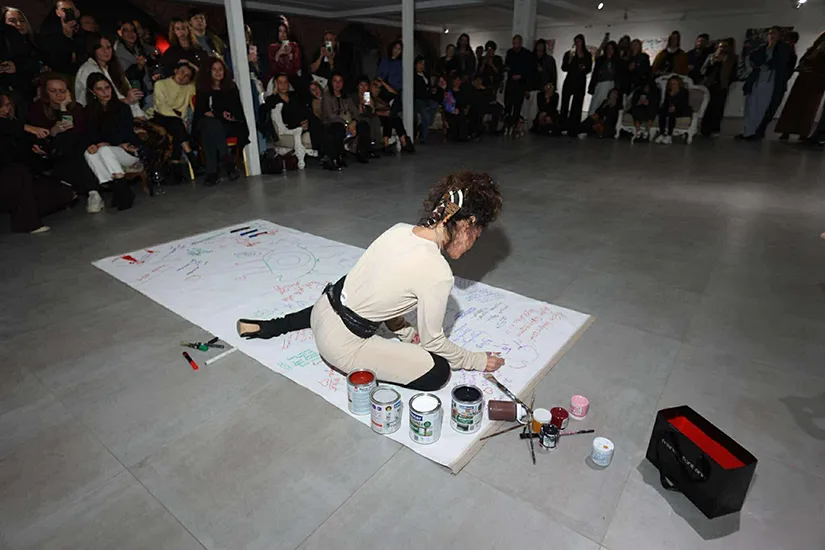
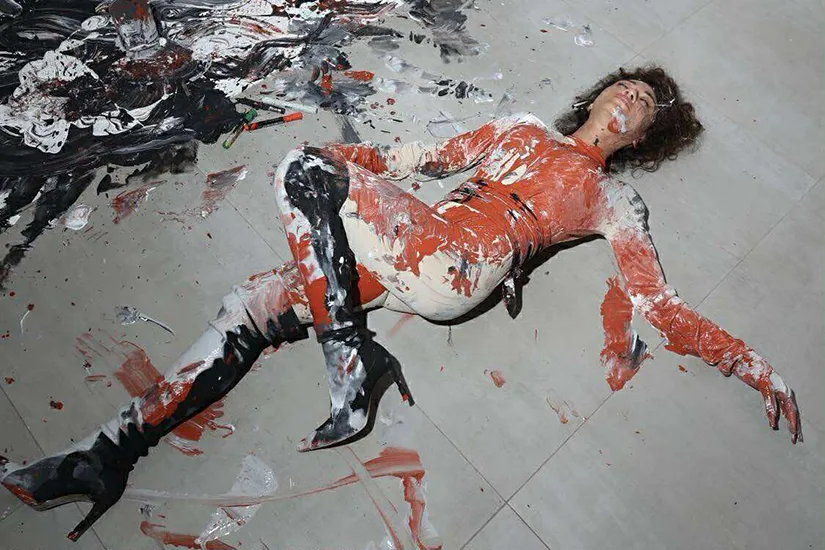
Can you tell us about your exhibition at Ria Keburia foundation? How did you come up with the title of the exhibition ?
გამოფენის სათაურშივე ჩანს, რომ თემა, რომლის გარშემოც ვითარდება პერფორმანსი და რომელსაც ეხება ნამუშევრების უმეტესობა, არის ადამიანური მდგომარეობები. იხილავთ რეალურ და შექმნილ პერსონაჟებს, რომლებიც ყვებიან სხვადასხვა ემოციური მდგომარეობის ამბავს. ეს სიუჟეტები არის ანარეკლი ჩემი ცხოვრების მომენტებიდან, რეალური თუ ფიქციური, განვრცობილი ჩემს ხელოვნებაში. ალბათ, მთავარი აზრი რაც მინდა, რომ გადმოვცე არის ის, რომ საჭიროა თავს მისცე უფლება განიცადო ყველაფერი, საჭიროა იცნობდე ყველა ემოციურ კონდინციას. ეს არის ის განაცხადი, რომლის გამოხატვასაც ვახერხებ ამ გამოფენით. ვცდილობ, რომ მაყურებელს ხელოვნების საშუალებით ყურადღება გადავატანინო საკუთარ თავზე და მან დაინახოს თავი გარემოში. ვიღაცისთვის შეიძლება გამოხატულმა მდგომარეობამ გააჩინოს ზრდის სურვილი, შეიქმნას ემოციური იმპულსები მდგომარეობებს შორის. ეს არის მცდელობა, რომ ხელოვნების დახმარებით დავუახლოვდეთ საკუთარ თავს. მთელი გამოფენა არის ამ ადამიანურ მდგომარეობებზე აწყობილი. უმეტესობა ნამუშევრების არის ახალი და პირველად გამოფენილი სივრცეში, თუმცა იხილავთ ძველ ტილოებსაც, რომლებიც კერძო კოლქციებიდან მოვითხოვეთ. ეს შერწყმა გამოსახავს გადასვლას, ცვლილებას ერთი მდგომარეობიდან მეორემდე. ცენტრალური ნამუშევარი არის პერფორმანსი, რომელიც გახსნის დღეს, ადგილზევე შეიქმნა.
The title of the exhibition itself reveals that the central theme around which the performance and most of the artworks develop is human states of being. You will see both real and imagined characters who tell stories of various emotional conditions. These narratives are reflections of moments from my life, real or fictional, expanded through my art.
The main idea I want to convey is that it’s important to allow yourself to experience everything, to be familiar with every emotional state. This exhibition is a statement expressing exactly that. I try, through art, to shift the viewer’s focus toward themselves — to help them see themselves within the environment. For some, the emotions expressed in the works may awaken a desire for growth or create emotional impulses between different states. It’s an attempt to bring people closer to themselves through art.
The entire exhibition is built around these human conditions. Most of the works are new and being shown for the first time in this space, though there will also be some older canvases taken from several private collections. This combination represents transition — the movement and transformation from one state to another. The central piece is a performance created live on the opening day.
რა თემებს იძიებთ და ეხებით თქვენს ახალ პერფორმანსებსა და ინსტალაციებში?
What are you currently exploring in your new performances and installations?
სამომავლოდ დიდი იმედი მაქვს, რომ გადავალ უფრო დიდ მაშტაბზე. განსაკუთრებით მსურს ქანდაკებების გადიდება. ახლა ამაზე ვმუშაობ და მგონია რომ, სულ მალე მივაღწევ ამ მიზანს.
In the future, I hope to work on a larger scale. I especially want to enlarge my sculptures. I’m currently working on this, I believe that very soon I will achieve this goal.
ესაუბრა თინა ჯანიაშვილი
Interviewed by Tina Janiashvili
ფოტო: მათე მათეშვილი
Photos by Mate Mateshvili
